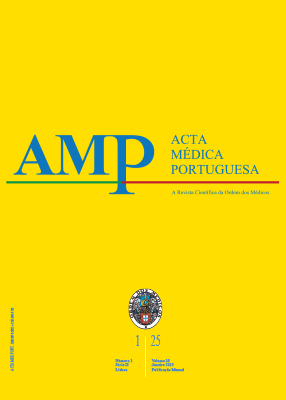Interactions between Insomnia, Sleep Disordered Breathing and Cardiometabolic Risk in Patients Complaining of Pain in the Orofacial Region
DOI:
https://doi.org/10.20344/amp.22350Keywords:
Cardiometabolic Risk Factors, Facial Pain, Sleep Apnea Syndromes, Sleep Initiation and Maintenance DisordersAbstract
The existence of intersected pathways between the mechanisms of insomnia, sleep-disordered breathing and persistent/chronic pain has been documented. Such concurrence will eventually contribute to a higher burden of cardiometabolic diseases, a main cause of death worldwide. The aim of this study was to evaluate the interactions between insomnia, sleep-disordered breathing, cardiometabolic risk, and psychosocial stress in patients seeking care at an orofacial pain clinic. Anonymized data of 1236 patients seeking care at the orofacial pain unit of the University of Zurich were analysed. Prevalence data was estimated for insomnia, sleep disordered breathing/sleep apnea and increased risk of a combination of insomnia and sleep disordered breathing/sleep apnea, both regarding demographics and cardiometabolic risk factors. Psychosocial stress factors acting as additional cardiometabolic risk factors were assessed. Among patients with persistent orofacial pain, increased risk of combination of insomnia and sleep disordered breathing/ sleep apnea was present in 11.5% of cases, and it was likely to increase psychosocial stress as an aditional independent risk factor for cardiometabolic
disorder.
Downloads
References
Meira E Cruz M, Salles C, Gozal D. A reappraisal on the associations between sleep-disordered breathing, insomnia, and cardiometabolic risk. Am J Resp Crit Care Med. 2021;203:1583-4.
Ren Z, Zhao Y, Niu G, Lian X, Zheng X, Wu S, et al. Healthy lifestyles and chronic pain with new-onset metabolic-related multimorbidity among older adults - China, 2011-2018. China CDC Wkly. 2023;5: 358-64.
Reynolds A, Minic Z. Chronic pain-associated cardiovascular disease: the role of sympathetic nerve activity. Int J Mol Sci. 2023;24:5378.
Santosa A, Rosengren A, Ramasundarahettige C, Rangarajan S, Gulec S, Chifamba J, et al. Psychosocial risk factors and cardiovascular disease and death in a population-based cohort from 21 low-, middle-, and high-income countries. JAMA Netw Open. 2021;4:e2138920.
Ettlin D, Sommer I, Brönnimann B, Maffioletti S, Sheidt J, Hou M, et al. Design, construction, and technical implementation of a web-based interdisciplinary symptom evaluation (WISE) - a heuristic proposal for orofacial pain and temporomandibular disorders. J Headache Pain. 2016;17:77.
Bastien CH, Vallières A, Morin CM. Validation of the insomnia severity index as an outcome measure for insomnia research. Sleep Med. 2001;2:297-307.
Löwe B, Decker O, Müller S, Brähler E, Schellerg D, Herzog W, et al. Validation and standardization of the generalized anxiety disorder screener (GAD-7) in the general population. Med Care. 2008;46:266-74.
Löwe B, Wahl I, Rose M, Spitzer C, Glaesmer H, Wingenfeld K, et al. A 4-item measure of depression and anxiety: validation and standardization of the Patient Health Questionnaire-4 (PHQ-4) in the general population. J Affect Disord. 2010;122:86-95.
Petrowski K, Schmalbach B, Tibubos A, Brähler E, Löwe B. Psychometric evaluation of the patient health questionnaire stress scale. J Affect Disord. 2024;357:37-41.
Osborne M, Shin L, Mehta N, Pitman R, Fayad Z, Tawakol A. Disentangling the links between psychosocial stress and cardiovascular disease. Circ Cardiovasc Imaging. 2020;13:e010931.
Meira E Cruz M, Lukic N, Wojczynska A, Steiger B, Guimarães AS, Ettlin D. Insomnia in patients seeking care at an orofacial pain unit. Front Neurol. 2019;10:542.
Meira e Cruz M, Gozal D, Salles C, Rocha I, Ettlin D. Sleep related respiratory impairment and psychosocial stress in patients with persistent orofacial pain: a cross-sectional exploratory study. Dent Med Probl. 2024 (in press). doi: 10.17219/dmp/195283.
Rhudy J, Huber F, Toledo T, Kell P, Street E, Shadlow J. Psychosocial and cardiometabolic predictors of chronic pain onset in Native Americans: serial mediation analyses of 2-year prospective data from the Oklahoma Study of Native American Pain Risk. Pain. 2022;163:e654-74.
Hein M, Lanquart J, Mungo A, Loas G. Cardiovascular risk associated with co-morbid insomnia and sleep apnoea (COMISA) in type 2 diabetics. Sleep Sci. 2022;15:184-94.
Meira E Cruz M, Salles C, Seixas L, D Elia C, Rocha I, Gozal D. Comorbid insomnia and sleep apnea in children: a preliminary explorative study. J Sleep Res. 2023;32:e13705.
Kauffman B, Kroeger R, Rogers A, Garey L, Ditre J, Zvolensky M. Anxiety sensitivity and modifiable cardiovascular disease risk factors: the role of pain intensity among individuals with chronic pain. J Behav Med. 2022;45:297-305.
Rodríguez-Sánchez I, Ortolá R, Graciani A, Martínez-Gómez D, Banegas J, Rodríguez-Artalejo F, et al. Pain characteristics, cardiovascular risk factors, and cardiovascular disease. J Gerontol A Biol Sci Med Sci. 2022;77:204-13.
Downloads
Published
How to Cite
Issue
Section
License
Copyright (c) 2024 Acta Médica Portuguesa

This work is licensed under a Creative Commons Attribution-NonCommercial 4.0 International License.
All the articles published in the AMP are open access and comply with the requirements of funding agencies or academic institutions. The AMP is governed by the terms of the Creative Commons ‘Attribution – Non-Commercial Use - (CC-BY-NC)’ license, regarding the use by third parties.
It is the author’s responsibility to obtain approval for the reproduction of figures, tables, etc. from other publications.
Upon acceptance of an article for publication, the authors will be asked to complete the ICMJE “Copyright Liability and Copyright Sharing Statement “(http://www.actamedicaportuguesa.com/info/AMP-NormasPublicacao.pdf) and the “Declaration of Potential Conflicts of Interest” (http:// www.icmje.org/conflicts-of-interest). An e-mail will be sent to the corresponding author to acknowledge receipt of the manuscript.
After publication, the authors are authorised to make their articles available in repositories of their institutions of origin, as long as they always mention where they were published and according to the Creative Commons license.









